Information injection-pump assembly
ZEXEL
107692-1310
1076921310
ISUZU
8943920080
8943920080
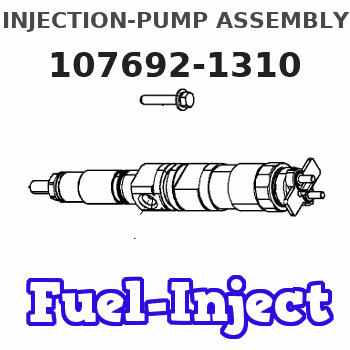
Rating:
Service parts 107692-1310 INJECTION-PUMP ASSEMBLY:
1.
_
5.
AUTOM. ADVANCE MECHANIS
9.
_
11.
Nozzle and Holder
8-94394-606-5
12.
Open Pre:MPa(Kqf/cm2)
21.6{220}
15.
NOZZLE SET
Include in #1:
107692-1310
as INJECTION-PUMP ASSEMBLY
Cross reference number
ZEXEL
107692-1310
1076921310
ISUZU
8943920080
8943920080
Zexel num
Bosch num
Firm num
Name
Calibration Data:
Adjustment conditions
Test oil
1404 Test oil ISO4113 or {SAEJ967d}
1404 Test oil ISO4113 or {SAEJ967d}
Test oil temperature
degC
40
40
45
Nozzle and nozzle holder
105780-8250
Bosch type code
1 688 901 101
Nozzle
105780-0120
Bosch type code
1 688 901 990
Nozzle holder
105780-2190
Opening pressure
MPa
20.7
Opening pressure
kgf/cm2
211
Injection pipe
Outer diameter - inner diameter - length (mm) mm 8-3-600
Outer diameter - inner diameter - length (mm) mm 8-3-600
Overflow valve
131425-0520
Overflow valve opening pressure
kPa
255
221
289
Overflow valve opening pressure
kgf/cm2
2.6
2.25
2.95
Tester oil delivery pressure
kPa
255
255
255
Tester oil delivery pressure
kgf/cm2
2.6
2.6
2.6
PS/ACT control unit part no.
407980-2
24*
Digi switch no.
17
Direction of rotation (viewed from drive side)
Left L
Left L
Injection timing adjustment
Direction of rotation (viewed from drive side)
Left L
Left L
Injection order
1-5-3-6-
2-4
Pre-stroke
mm
5.1
5.07
5.13
Beginning of injection position
Governor side NO.1
Governor side NO.1
Difference between angles 1
Cal 1-5 deg. 60 59.75 60.25
Cal 1-5 deg. 60 59.75 60.25
Difference between angles 2
Cal 1-3 deg. 120 119.75 120.25
Cal 1-3 deg. 120 119.75 120.25
Difference between angles 3
Cal 1-6 deg. 180 179.75 180.25
Cal 1-6 deg. 180 179.75 180.25
Difference between angles 4
Cyl.1-2 deg. 240 239.75 240.25
Cyl.1-2 deg. 240 239.75 240.25
Difference between angles 5
Cal 1-4 deg. 300 299.75 300.25
Cal 1-4 deg. 300 299.75 300.25
Injection quantity adjustment
Adjusting point
-
Rack position
14.4
Pump speed
r/min
750
750
750
Average injection quantity
mm3/st.
120
118.4
121.6
Max. variation between cylinders
%
0
-2.5
2.5
Basic
*
Fixing the rack
*
PS407980-224*
V
2.25+-0.
01
PS407980-224*
mm
3.1+-0.0
5
Standard for adjustment of the maximum variation between cylinders
*
Injection quantity adjustment_02
Adjusting point
Z
Rack position
9+-0.5
Pump speed
r/min
425
425
425
Average injection quantity
mm3/st.
19
17.7
20.3
Max. variation between cylinders
%
0
-14
14
Fixing the rack
*
PS407980-224*
V
V1+0.05+
-0.01
PS407980-224*
mm
5+-0.03
Standard for adjustment of the maximum variation between cylinders
*
Remarks
Refer to items regarding the pre-stroke actuator
Refer to items regarding the pre-stroke actuator
Injection quantity adjustment_03
Adjusting point
A
Rack position
R1(14.4)
Pump speed
r/min
750
750
750
Average injection quantity
mm3/st.
120
119
121
Basic
*
Fixing the lever
*
Boost pressure
kPa
61.3
61.3
Boost pressure
mmHg
460
460
PS407980-224*
V
2.25+-0.
01
PS407980-224*
mm
3.1+-0.0
5
Boost compensator adjustment
Pump speed
r/min
300
300
300
Rack position
R2-2.7
Boost pressure
kPa
17.3
16
18.6
Boost pressure
mmHg
130
120
140
Boost compensator adjustment_02
Pump speed
r/min
300
300
300
Rack position
R2(R1-0.
55)
Boost pressure
kPa
48
48
48
Boost pressure
mmHg
360
360
360
0000001601
CU407980-224*
*
Actuator retarding type
*
Supply voltage
V
24
23.5
24.5
Ambient temperature
degC
23
18
28
Pre-stroke
mm
2
1.95
2.05
Output voltage
V
2.83
2.82
2.84
Adjustment
*
_02
CU407980-224*
*
Supply voltage
V
24
23.5
24.5
Ambient temperature
degC
23
18
28
Pre-stroke
mm
5.1
5.07
5.13
Output voltage
V
1.2
1
1.4
Confirmation
*
Remarks
Output voltage V1
Output voltage V1
_03
CU407980-224*
*
Supply voltage
V
24
23.5
24.5
Ambient temperature
degC
23
18
28
Output voltage
V
3.05
3.05
Confirmation of operating range
*
Test data Ex:
Governor adjustment

N:Pump speed
R:Rack position (mm)
(1)Torque cam stamping: T1
(2)Tolerance for racks not indicated: +-0.05mm.
(3)Boost compensator stroke: BCL
----------
T1=AF75 BCL=2.7+-0.1mm
----------
----------
T1=AF75 BCL=2.7+-0.1mm
----------
Speed control lever angle
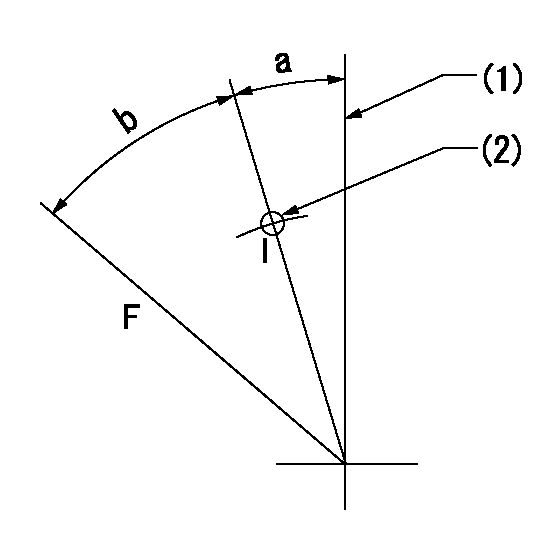
F:Full speed
I:Idle
(1)Use the pin at R = aa
(2)Stopper bolt set position 'H'
----------
aa=35mm
----------
a=2deg+-5deg b=32.5deg+-3deg
----------
aa=35mm
----------
a=2deg+-5deg b=32.5deg+-3deg
Stop lever angle
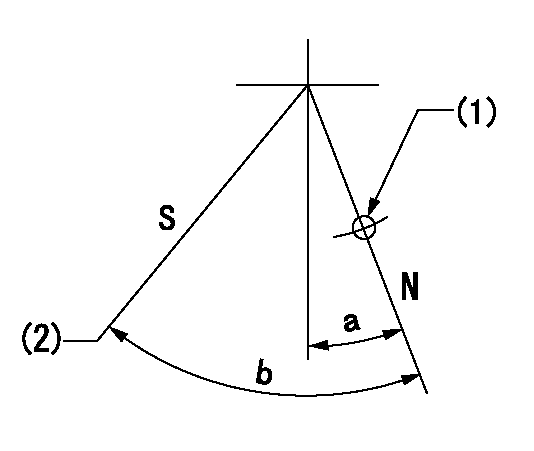
N:Pump normal
S:Stop the pump.
(1)Use the pin at R = aa
(2)Set the stopper bolt at speed = bb and rack position = cc (non-injection rack position). Confirm non-injection.
----------
aa=40mm bb=0r/min cc=1.5+-0.3mm
----------
a=12deg+-5deg b=44deg+-5deg
----------
aa=40mm bb=0r/min cc=1.5+-0.3mm
----------
a=12deg+-5deg b=44deg+-5deg
0000001301

(1)Pump vertical direction
(2)Position of flywheel's threaded hole at No 1 cylinder's beginning of injection
(3)B.T.D.C.: aa
(4)Pre-stroke: bb
----------
aa=1deg bb=5.1+-0.03mm
----------
a=(50deg)
----------
aa=1deg bb=5.1+-0.03mm
----------
a=(50deg)
0000001401
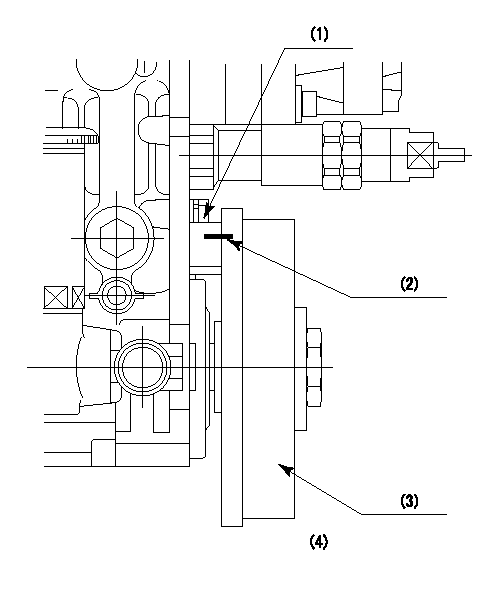
(1)Pointer
(2)Injection timing aligning mark
(3)Fly weight
(4)The actual shape and direction may be different from this illustration.
Operation sequence
1. Turn the prestroke actuator OFF.
2. Turn the camshaft as far as the No.1 cylinder's beginning of injection position.
3. Check that the pointer alignment mark of the injection pump and the alignment mark of the flywheel are matching.
4. If they are not matching, erase the alignment mark on the flywheel side, and stamp an alignment mark on the flywheel position that matches with the pointer side alignment mark.
5. Check again that the coupling's key groove position is in the No.1 cylinder's beginning of injection position.
----------
----------
----------
----------
0000001701
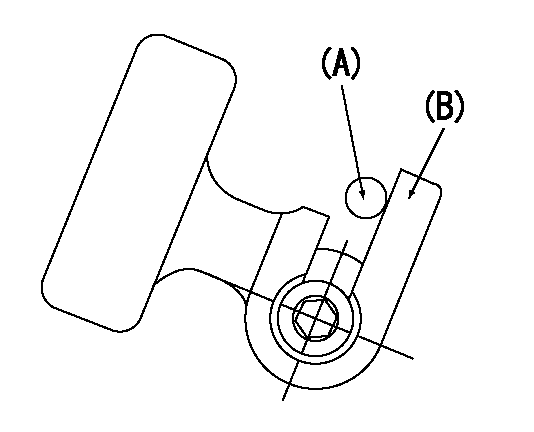
A : Stopper pin
B: Connector
----------
----------
----------
----------
0000001801
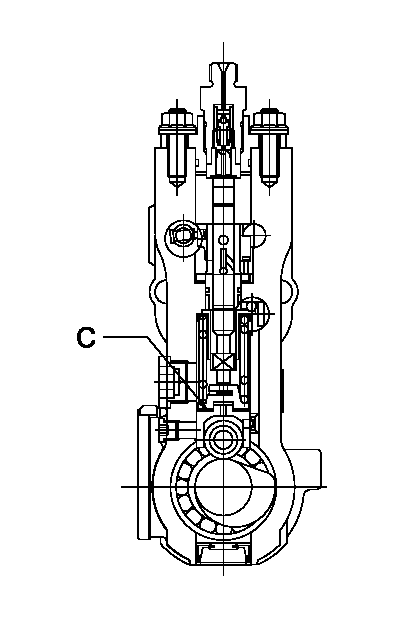
C:Shim
----------
----------
----------
----------
0000001901
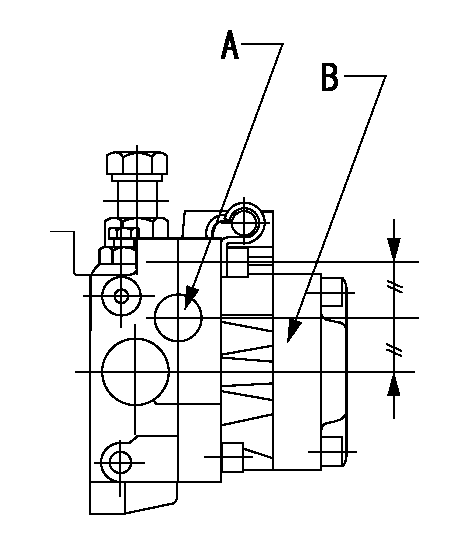
A:Sealing position
B:Pre-stroke actuator
1. When installing the pre-stroke actuator on the pump, first tighten the installation bolts loosely, then move the actuator fully clockwise (viewed from the drive side).
Temporary tightening torque: 1 - 1.5 N.m (0.1 - 0.15 kgf.m)
2. Move the actuator in the counterclockwise direction when viewed from the drive side, and adjust so that it becomes the adjustment point of the adjustment value. Then tighten it.
Tightening torque: 7^9 N.m (0.7^0.9 kgf.m)
3. After prestroke actuator installation adjustment, simultaneously stamp both the actuator side and housing side.
----------
----------
----------
----------
0000002201 RACK SENSOR
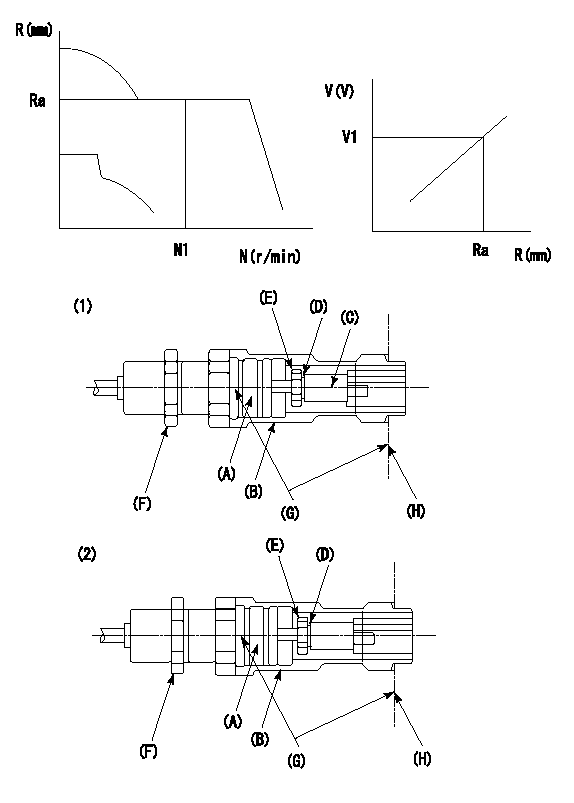
G:Red paint
H:Pump end face
P/N: part number of suitable shim
(1)Threaded type rack block
(2)Welded type rack block
Rack sensor adjustment
1. Threaded type rack sensor (-5*20, P type, no TICS rack limit).
(1)Screw in the bobbin (A) until it contacts the joint (B).
(2)Fix the pump lever.
(3)At speed N1 and rack position Ra, adjust the amount that the bobbin is screwed in so that the amp's output voltage is V1.
(4)Fix using the nut (F).
(5)Affix the caution plate to the upper part of the joint (B).
(6)Apply (G) at two places.
Connecting part between the joint (B) and the nut (F)
Connecting part between the end surface of the pump (H) and the joint (B)
2. Range for screw-in adjustment between the bobbin (A) and the joint (B) is 9 threads.
Screw in to the end from (the position where the bobbin (A) is rotated 9 turns).
Speed N1, rack position Ra, output voltage V1, rack sensor supply voltage 5+-0.01 (V)
----------
Ra=R1(14.4)+2.65mm N1=1250r/min V1=3+-0.01V
----------
----------
Ra=R1(14.4)+2.65mm N1=1250r/min V1=3+-0.01V
----------
0000002301 ACS
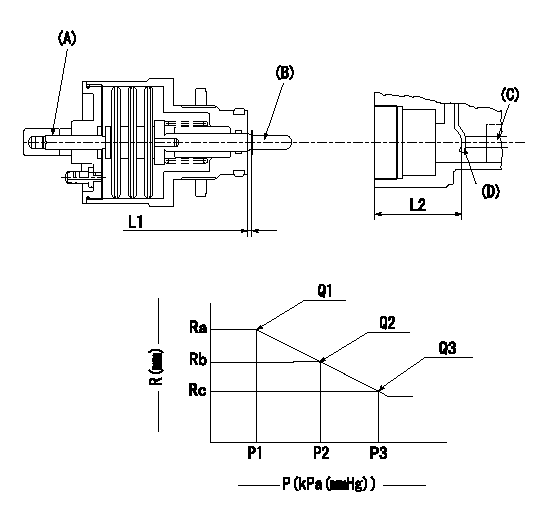
(A) Set screw
(B) Push rod 1
(C) Push rod 2
(D) Lever
1. Aneroid compensator unit adjustment
(1)Screw in (A) to obtain L1.
(2)Select C so that dimension L2 can be obtained.
2. Adjustment when mounting the governor.
(1)Set the speed of the pump to N1 r/min and fix the control lever at the full set position.
(2)Set to full boost.
(3)Screw in the aneroid compensator body to obtain the performance shown in the graph above.
(4)As there is hysterisis, measure when the absolute pressure drops.
(5)Hysterisis must not exceed rack position = h1.
----------
N1=1250r/min L1=1.5+-0.5mm L2=37.5+-0.5mm h1=0.15mm
----------
Ra=R3(R1+2.65)mm Rb=R3-0.15mm Rc=R3-0.5mm P1=(89.9)+-2.7kPa((674)+-20mmHg) P2=84.6+-2.7kPa(635+-20mmHg) P3=70.1+-0.7kPa(526+-5mmHg) Q1=(135)cm3/1000st Q2=(133)cm3/1000st Q3=(128.5)+-2cm3/1000st
----------
N1=1250r/min L1=1.5+-0.5mm L2=37.5+-0.5mm h1=0.15mm
----------
Ra=R3(R1+2.65)mm Rb=R3-0.15mm Rc=R3-0.5mm P1=(89.9)+-2.7kPa((674)+-20mmHg) P2=84.6+-2.7kPa(635+-20mmHg) P3=70.1+-0.7kPa(526+-5mmHg) Q1=(135)cm3/1000st Q2=(133)cm3/1000st Q3=(128.5)+-2cm3/1000st
Information:
Clean/Replace Standard Air Cleaner Elements
Never service the air cleaner with the engine running since this will allow dirt to enter the engine. Check the vessel air duct inlet piping for leaks. Make all repairs to air ducts and inlet piping immediately, as dirt and debris could enter the engine causing damage to the turbocharger and engine components.Clean or replace elements using these recommendations and/or your weather and operating conditions, or when required by the restriction indicator.
1. Remove air cleaner cover and element. Clean or discard used element. Refer to SEBF8062, Guideline for Reusable Parts-Cleaning and Inspection of Air Filters.2. Cover air inlet opening with a clean cloth or towel to prevent dirt and debris from entering the engine.3. Clean the inside of the air cleaner cover and body.Cleaning with Water, Air or Detergent
Do not clean the filter elements by bumping or tapping them. Engine damage could result.
Filter elements can be cleaned with pressure air - 205 kPa (30 psi) maximum, pressure water - 280 kPa (40 psi) maximum, or detergent washing. Direct air or water along the pleats inside and outside of filter element. The element can be washed in warm water and nonsudsing household detergent. Rinse inside and outside the pleats and air dry fully.Inspect the filter elements after cleaning. Do not use a filter element with damaged pleats, gaskets or seals. Wrap and store the clean filter elements in a clean, dry place. Remove cloth from air inlet opening and install clean element while noting arrows indicating air flow on the side of the element. Install cover and reset service indicator.Cleaning Marine Air Cleaner Elements
1. Remove the air cleaner (1) and vacuum limiter element(s) (2). Tap the elements gently to dislodge any large particles. Gently brush the filter elements with a soft bristle brush.
NEVER use gasoline, steam, caustic or unapproved detergents or parts cleaning solvents. Never use high pressure water or air for cleaning. Using any of these liquids or methods will cause filter element damage.
Use the 102-9720 (U.S.) or 102-9721 (non-U.S.) Cleaning Kit exclusively. The kit contains detergent and oil products specifically for the maintenance of the air and vacuum limiter filter elements.2. Spray cleaning solution on the elements and allow to soak for ten minutes. Rinse the element(s) with low pressure water (tap water is acceptable) from the inside (clean side) out (dirty side) to remove dirt and debris and not drive them into element material.3. Shake off excess water and dry filter elements naturally and thoroughly. Inspect housing and clamp. Replace if necessary.
DO NOT dry elements with compressed air, open flame or heat dryers. Excess heat will shrink cotton fiber and compressed air may blow holes in material.
4. Inspect filter elements after cleaning for tears and/or holes in filter material. Do not re-use damaged filters, replace if necessary.
NEVER use automatic transmission fluid, motor oil, diesel fuel or lightweight oils to re-oil filter element. Do NOT install and operate engine with element dry.
5. Always re-oil filter elements before installing. Squeeze oil down into bottom
Never service the air cleaner with the engine running since this will allow dirt to enter the engine. Check the vessel air duct inlet piping for leaks. Make all repairs to air ducts and inlet piping immediately, as dirt and debris could enter the engine causing damage to the turbocharger and engine components.Clean or replace elements using these recommendations and/or your weather and operating conditions, or when required by the restriction indicator.
1. Remove air cleaner cover and element. Clean or discard used element. Refer to SEBF8062, Guideline for Reusable Parts-Cleaning and Inspection of Air Filters.2. Cover air inlet opening with a clean cloth or towel to prevent dirt and debris from entering the engine.3. Clean the inside of the air cleaner cover and body.Cleaning with Water, Air or Detergent
Do not clean the filter elements by bumping or tapping them. Engine damage could result.
Filter elements can be cleaned with pressure air - 205 kPa (30 psi) maximum, pressure water - 280 kPa (40 psi) maximum, or detergent washing. Direct air or water along the pleats inside and outside of filter element. The element can be washed in warm water and nonsudsing household detergent. Rinse inside and outside the pleats and air dry fully.Inspect the filter elements after cleaning. Do not use a filter element with damaged pleats, gaskets or seals. Wrap and store the clean filter elements in a clean, dry place. Remove cloth from air inlet opening and install clean element while noting arrows indicating air flow on the side of the element. Install cover and reset service indicator.Cleaning Marine Air Cleaner Elements
1. Remove the air cleaner (1) and vacuum limiter element(s) (2). Tap the elements gently to dislodge any large particles. Gently brush the filter elements with a soft bristle brush.
NEVER use gasoline, steam, caustic or unapproved detergents or parts cleaning solvents. Never use high pressure water or air for cleaning. Using any of these liquids or methods will cause filter element damage.
Use the 102-9720 (U.S.) or 102-9721 (non-U.S.) Cleaning Kit exclusively. The kit contains detergent and oil products specifically for the maintenance of the air and vacuum limiter filter elements.2. Spray cleaning solution on the elements and allow to soak for ten minutes. Rinse the element(s) with low pressure water (tap water is acceptable) from the inside (clean side) out (dirty side) to remove dirt and debris and not drive them into element material.3. Shake off excess water and dry filter elements naturally and thoroughly. Inspect housing and clamp. Replace if necessary.
DO NOT dry elements with compressed air, open flame or heat dryers. Excess heat will shrink cotton fiber and compressed air may blow holes in material.
4. Inspect filter elements after cleaning for tears and/or holes in filter material. Do not re-use damaged filters, replace if necessary.
NEVER use automatic transmission fluid, motor oil, diesel fuel or lightweight oils to re-oil filter element. Do NOT install and operate engine with element dry.
5. Always re-oil filter elements before installing. Squeeze oil down into bottom